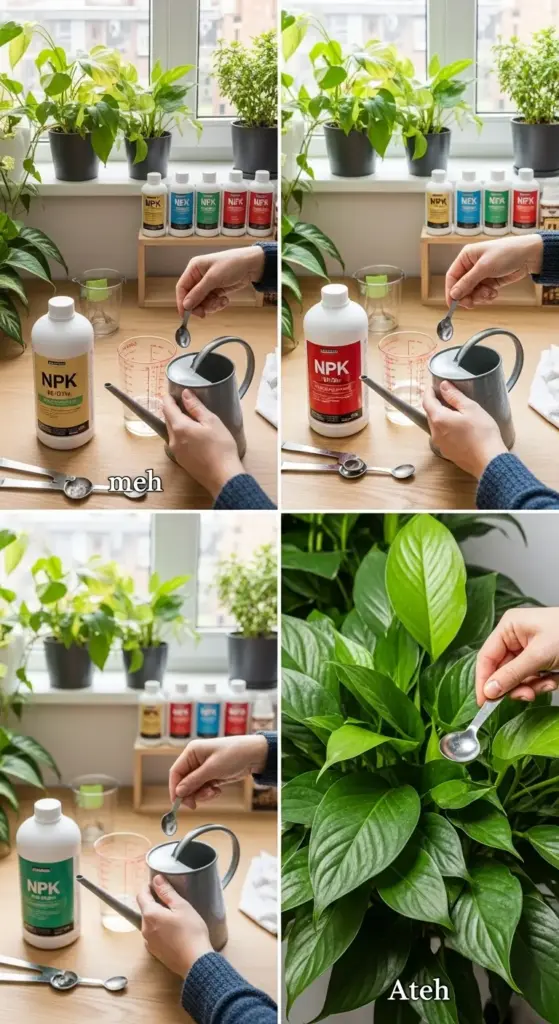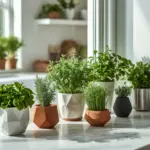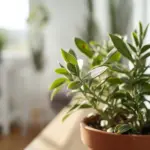5. Feed Your Plants for Maximum Growth

I used to think plants just lived off water and sunlight like some kind of green magic. Then I wondered why my plants looked so… meh.
Turns out, they were basically starving while I patted myself on the back for keeping them alive.
Understanding NPK Ratios and Fertilizer basics
NPK stands for nitrogen, phosphorus, and potassium – the big three nutrients plants crave. Those numbers on fertilizer bottles? That’s the NPK ratio.
Nitrogen (N) makes leaves green and lush. Too little and your plant looks pale and sad.
Phosphorus (P) helps with root development and flowering. Essential for getting those gorgeous blooms on your flowering plants.
Potassium (K) strengthens the whole plant and helps with disease resistance. Think of it as plant vitamins.
A 20-20-20 fertilizer means 20% each of NPK. Balanced fertilizers like this work great for most houseplants.
High nitrogen fertilizers (like 30-10-10) are perfect for leafy plants like pothos and monstera. I use these during growing season for my foliage plants.
Bloom boosters have higher phosphorus numbers (like 10-30-20). Great for getting stubborn plants to flower.
I learned this the hard way when I kept feeding my flowering begonia high-nitrogen fertilizer. Gorgeous leaves, zero flowers!
Organic vs. Synthetic Fertilizer Options
Synthetic fertilizers work fast but can burn plants if you overdo it. Been there, done that, killed a spider plant.
I accidentally double-dosed my poor spider plant with liquid fertilizer and watched its leaf tips turn brown within days.
Organic fertilizers release nutrients slowly and are harder to mess up. They’re like a gentle, steady meal instead of fast food.
Fish emulsion smells absolutely terrible but plants go crazy for it. I only use it outdoors now after stinking up my apartment.
Worm castings are basically plant gold. Gentle, slow-release, and impossible to overuse. My plants have never looked better since I started mixing these into potting soil.
Compost tea is like a nutritious smoothie for plants. I make it by steeping compost in water for a few days.
Kelp meal provides trace minerals that synthetic fertilizers often miss. It’s like a multivitamin for your green babies.
Seasonal Feeding Schedules
Spring and summer are growing season – that’s when plants are hungry and actively growing. I fertilize every 2-4 weeks during these months.
Fall feeding should taper off as growth slows down. I usually stop fertilizing by October.
Winter is fasting time for most houseplants. They’re basically hibernating and don’t need extra nutrients.
I made the mistake of fertilizing through winter my first year. Plants got weak, leggy growth that couldn’t support itself.
Slow-release fertilizer pellets are perfect for people who forget schedules. Sprinkle them on soil in spring and you’re done for months.
Liquid fertilizers give you more control but require consistent application. I use these for my high-maintenance plants.
Signs Your Plants Need Nutrients
Pale, yellowing leaves (starting from the bottom) usually mean nitrogen deficiency. This was my first clue that my plants were hungry.
Slow growth during growing season is another red flag. If your plant should be putting out new leaves but isn’t, it might need food.
Purple or reddish leaf tints can indicate phosphorus deficiency. I noticed this on my prayer plant before I started regular feeding.
Brown leaf edges might mean potassium deficiency, but it can also be from overwatering or low humidity. Plant diagnosis is tricky!
Small, weak new growth compared to older leaves is a sure sign your plant needs nutrients.
Overall lackluster appearance – when plants just look “blah” despite proper light and water – often means they need feeding.
DIY Fertilizer Recipes Using Kitchen Scraps
Banana peel water is loaded with potassium. I soak peels in water for a few days, then use the liquid to water plants.
Coffee grounds add nitrogen but need to be composted first. Fresh grounds are too acidic and can harm plants.
Eggshell water provides calcium. Crush shells, soak in water overnight, then use for watering.
Aquarium water from freshwater tanks is fantastic plant fertilizer. All those fish waste nutrients are perfect for plants!
Epsom salt (magnesium sulfate) helps with chlorophyll production. I dissolve 1 tablespoon per gallon of water monthly.
Cooking water from vegetables contains nutrients that leached out during cooking. Let it cool completely before using.
I tried making compost tea in my kitchen once. Big mistake – it smelled like a swamp and attracted fruit flies!
Budget-Friendly Feeding Solutions
Generic liquid fertilizer works just as well as expensive brands. I buy the store brand and dilute it to quarter strength.
Slow-release pellets seem expensive upfront but last 3-6 months. Way cheaper than buying liquid fertilizer monthly.
Worm castings from the garden center cost way less than fancy organic fertilizers and work better than most.
Making your own compost is free if you have kitchen scraps and patience. Takes months but costs nothing.
Fish emulsion concentrate goes a long way when diluted properly. One bottle lasts me an entire growing season.
Buying fertilizer in bulk during spring sales saves tons of money. I stock up when garden centers have their big sales.
Diluting fertilizer to half or quarter strength lets you feed more often without burning plants or breaking the bank.
I learned that less is more with plant feeding. Better to underfeed slightly than to overfeed and cause problems.
Ready to protect your well-fed plants from common problems? The next section covers monitoring and preventing plant issues – including the early warning signs I wish I’d known about and the simple prevention strategies that could save your entire collection. Click “next” to become a plant problem detective!









GIPHY App Key not set. Please check settings